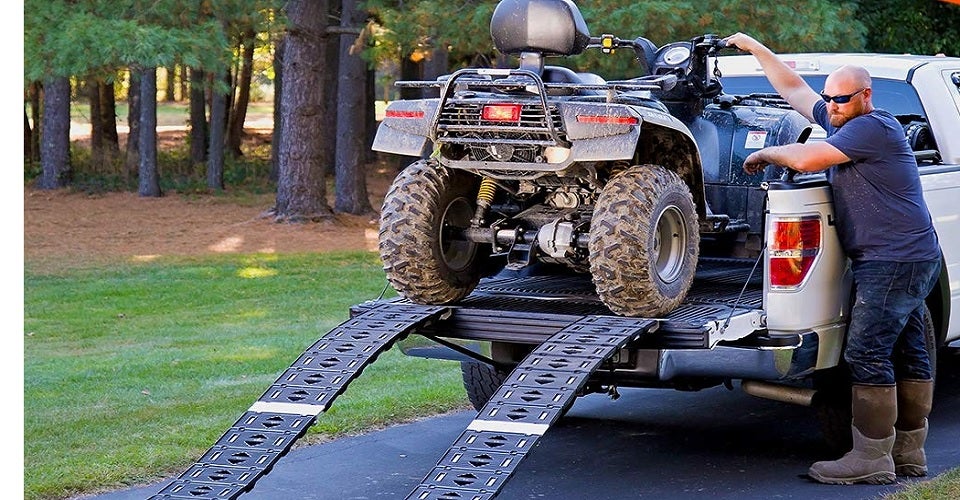
Our Editors independently research, test, and rate what we feel are the best products. We use affiliate links and may receive a small commission on purchases.
A quick search on the internet will reveal an endless supply of loading ramp fails. While failing to pick the right loading ramp might lead to a good video for some, it will almost certainly lead to injury and damage at the moment.
Before you run out and just buy the first loading ramps you come across, pause to consider what to buy. Loading ramps come in different sizes, shapes, lengths, materials, and ratings.
Choosing a top loading ramp is the first step to ensure that your equipment is loaded and unloaded safely every time.
For more of my truck and 4x4 recommendations, have a look through these popular Outside Pursuits guide links: Truck Bed Covers, Truck Winches. Truck Tool Boxes.
Quick Answer: The Best Rated Loading Ramps
- CARGOSMART Hybrid S-Curve Centerfold Ramp
- Five Star Aluminum Motorcycle Ramp
- Black Ice Snowmobile Loading Ramp
- Rage Powersports Black Widow Bi-Fold ATV Ramp
- Black Widow Bi-Fold ATV Ramp
- Rage Powersports Aluminum ATV Ramps
Loading Ramp Reviews
#1 CARGOSMART Hybrid S-Curve Centerfold Ramp
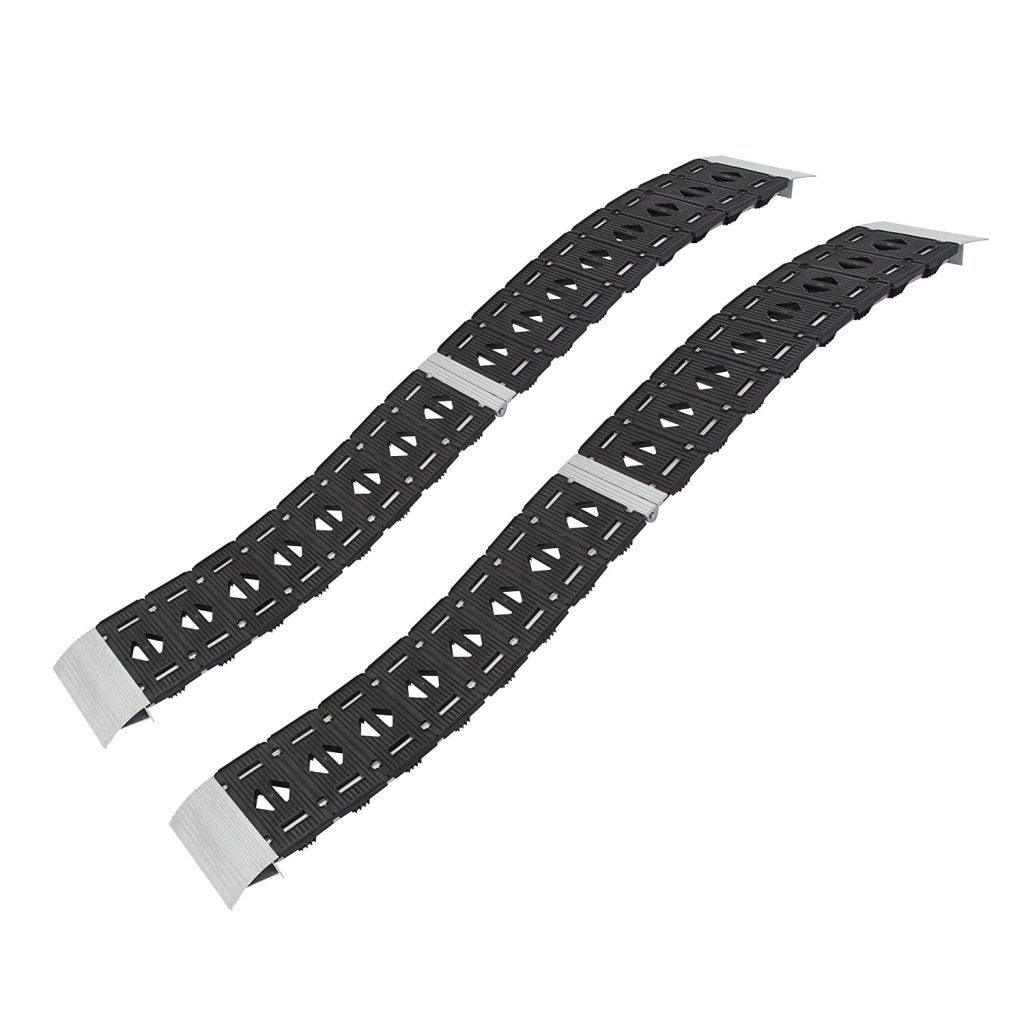
- Length: 7’6”
- Width: 12”
- Weight Capacity: 1,500 Pounds /Pair
- Ramp Weight: 62 Pounds
Cargosmart went back to the drawing board when they designed this ramp. They made these ramps with a gentle curving shape which is supposed to help ease the transition onto and off of the ramp.
These ramps are made from a combination of synthetics and aluminum. They fold in half in the middle and that turns them into 45” long ramps when stored.
We’re looking at maybe 30 pounds per ramp so keep that in mind logistically.
While I can’t say if the S-shaped design actually makes things easier to load and unload, it does seem smooth.
The ramps are lined with an aggressive traction tread for grip. However, these ramps are just 12” wide each so don’t make a mistake when lining up your loading!
For safety, there are included adjustable safety straps to help secure your loading process. We would rate the Cargosmart’s the best ATV ramps for smooth loading and unloading.
#2 Five Star Aluminum Motorcycle Ramp
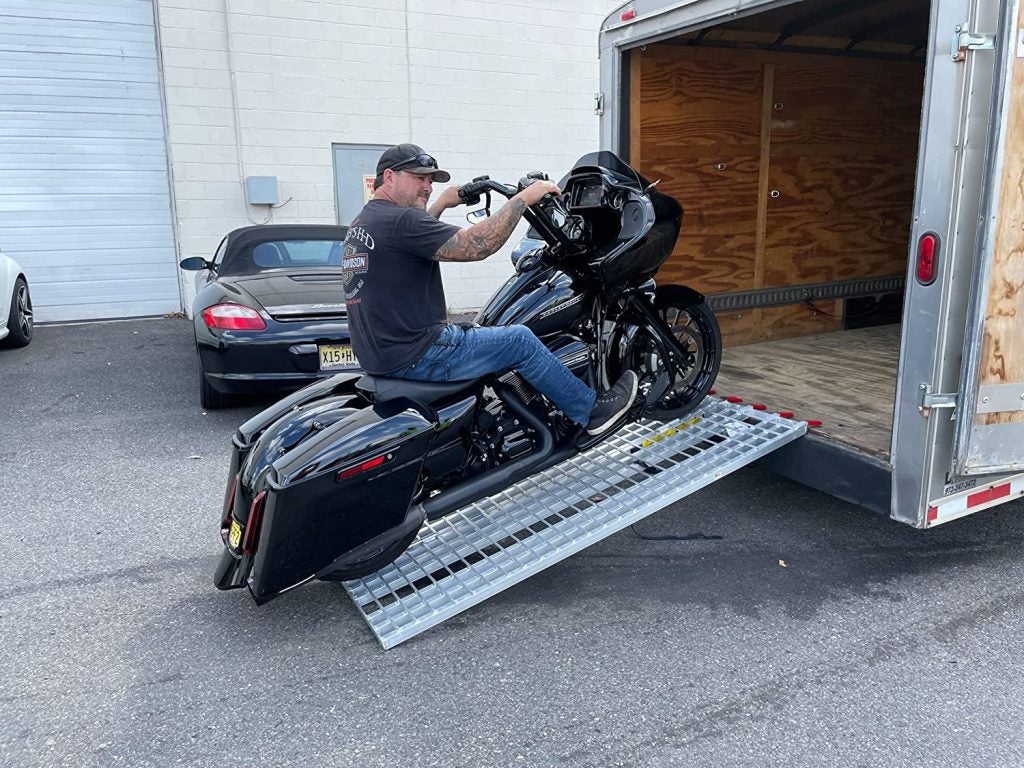
- Length: 6’10”
- Width: 40”
- Weight Capacity: 1,200 Pounds
- Ramp Weight: 38 Pounds
Looking for a single ramp that can handle pretty much any loading situation? This ramp by Five Star is a full 40” wide which means you can walk, ride, drive, push, or pull your way up it.
At almost 7’ long this ramp won’t be the top pick for lifted trucks. However, trailers, regular height trucks, and other utility vehicles should all benefit.
To help prevent slipping when loading, all of the cross rods on this ramp are serrated for traction. That means less likelihood of tires or feet slipping during the loading process.
They designed this ramp specifically for loading motorcycles. It has extra support in the center for two-wheel vehicles.
Additionally, the 40” width means there’s enough room to firmly plant your feet for balance when loading or walking the bike on or off. If you want the best motorcycle loading ramps for trailers or short trucks, look no further!
#3 Black Ice Snowmobile Loading Ramp
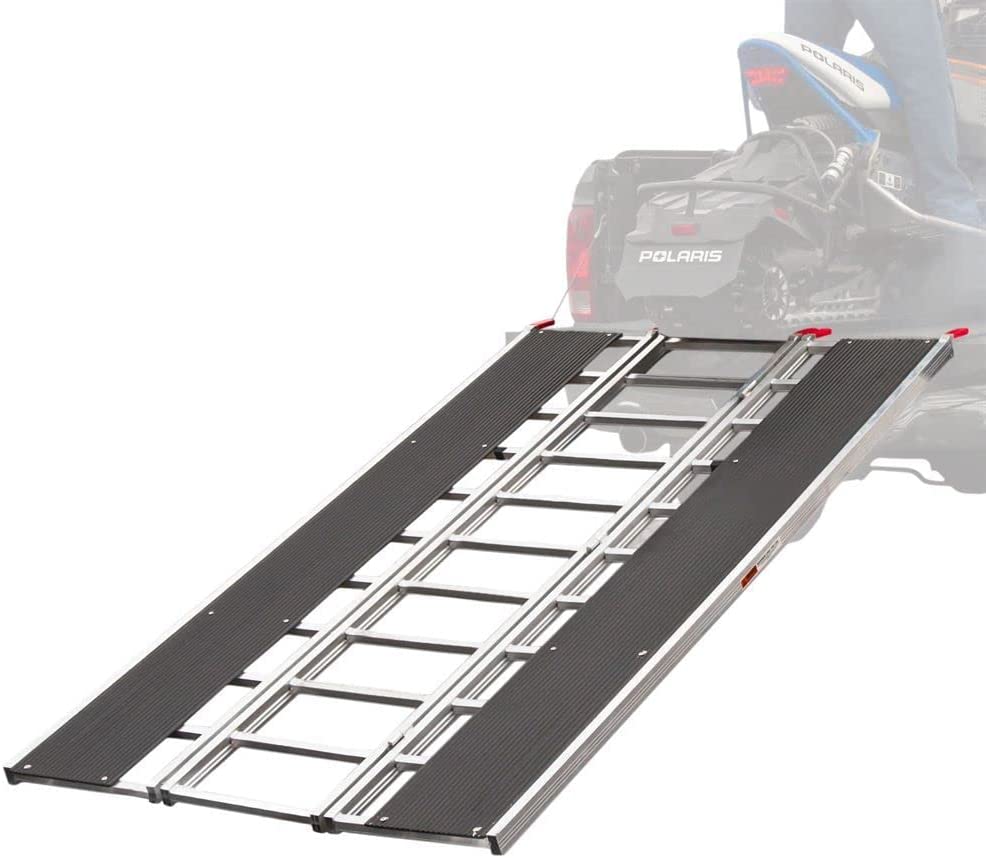
- Length: 7’10”
- Width: 54”
- Weight Capacity: 1,500 Pounds
- Ramp Weight: 49 Pounds
If you can’t tell by the title, this one is aimed at the snowmobile riders. While it’s possible you could use this ramp for other things, it has features designed exactly for the snowmobile crowd.
On either side of the ramp are two 12” wide vinyl loading slides to guide your skis up on the truck. They’re designed to keep friction as low as possible to make loading easier.
Along the center of the ramp is an open slatted track. This engages positively with your sled’s track for confident loading and unloading.
In order to keep everything secure, the ramp comes with two straps. Using these straps is a must in order to stay safe and prevent the ramp from slipping off the tailgate.
When stored the ramp packs down to just 17.5” wide but it remains the full 7’ 10” long so you’ll need a full size truck bed to get these bad boys to travel with you. Without a doubt, the best snowmobile ramps for truck bed loading!
#4 Rage Powersports Black Widow Bi-Fold ATV Ramp
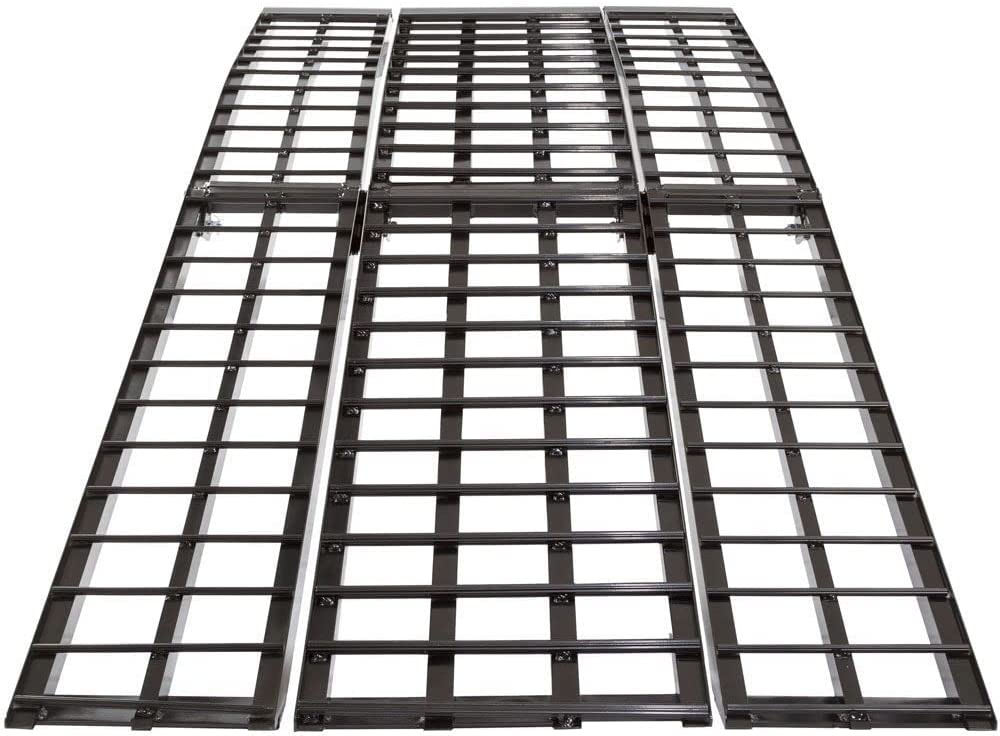
- Length: 7’10”
- Width: 40”
- Weight Capacity: 1,500 Pounds
- Ramp Weight: 81 Pounds
While the name might be a little over-the-top, this ramp is sure to fit the needs of a wide variety of users. It is made specifically for motorcycles, however, so keep that in mind as you browse.
Let’s start by talking about the weight of the ramp itself. They’ve listed it at 81 pounds of “shipping weight” so the ramp itself may be slightly lighter than that.
Either way, though, 80 pounds is pretty heavy. Remember, though, that this ramp comes apart into two pieces, so you’ll only need to pick up and move about 40 pounds at a time when storing.
It’s made from aluminum with ribbed cross bars for traction. Like all loading ramps, you’ll need to use the included safety straps to make sure the ramp doesn’t kick out from under you when loading.
At 40” wide it should have enough room for your bike while still leaving space to firmly plant your feet for balance. If you have a taller truck or trailer, these are ideal loading ramps.
#5 Black Widow Bi-Fold ATV Ramp
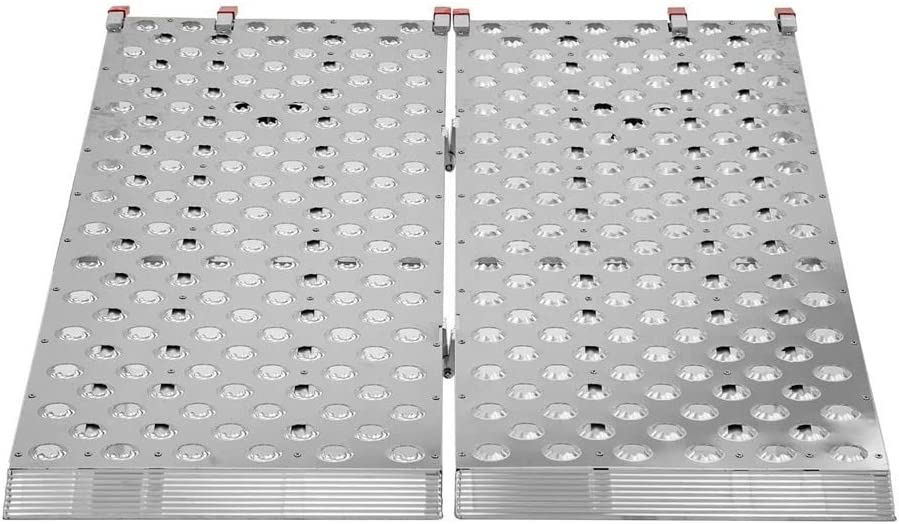
- Length: 5’10”
- Width: 44”
- Weight Capacity: 1,500 Pounds
- Ramp Weight: 39.5 Pounds
We’re back with another Black Widow. This time, however, it’s purpose-made for ATVs, lawn mowers, and other small power equipment.
First up, I want to point out that this ramp isn’t super long. At just under 6’ it’s going to be a steep climb onto taller truck beds. Keep that in mind.
This ramp is made from a high traction punch-plate for grip. It folds in half in the middle. At the top are fingers that hold the edge of the tailgate. Of course, you’ll also want to use the two safety straps.
Before you buy this ramp you’ll want to check the width of your power equipment’s wheel base. Hint: it needs to be 44” or less!
When folded this ramp will measure 22” wide (less than 2 feet) and just under 6’ long. Perfect for loading small power equipment onto lower, small bed trucks.
#6 Rage Powersports Aluminum ATV Ramps
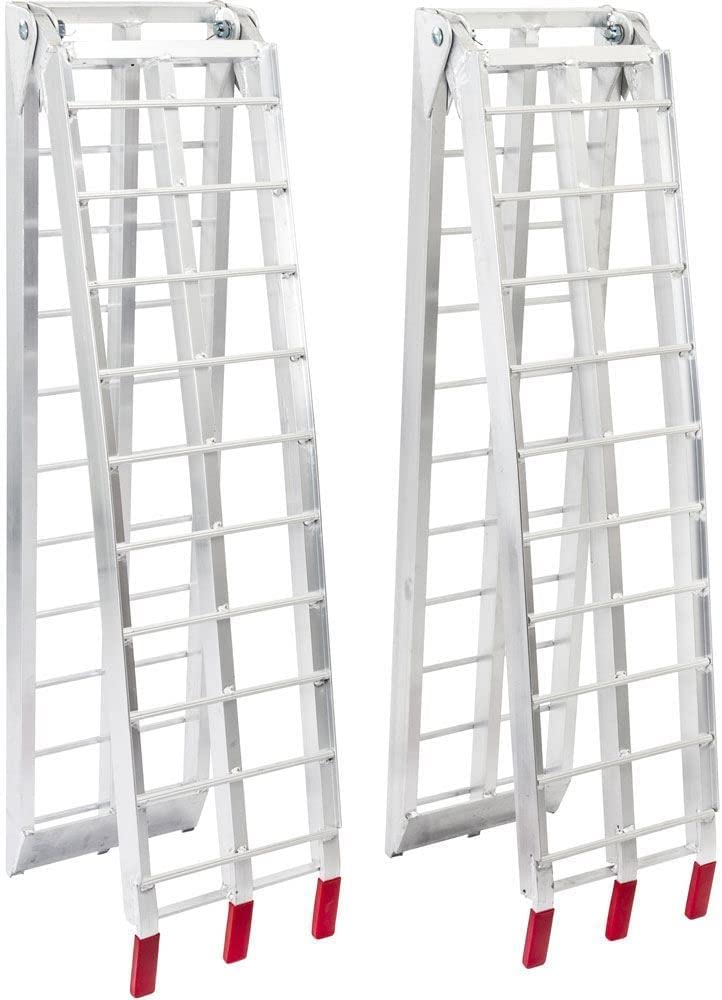
- Length: 7’6″
- Width: 11”
- Weight Capacity: 1,500 Pounds /Pair
- Ramp Weight: 14.5 Pounds
Last but not least are the Aluminum ATV Ramps from Rage Powersports. These ramps are aimed right at truck bed loading, but work great for trailers as well.
As always, these ramps come with a set of safety straps. At just 7’6″ they’re long enough most any height truck or trailer.
Just like the Gardhom’s, each ramp has 3 rubber coated red fingers that slip over the truck tailgate or trailer edge to provide support and security.
While they are rated for 750 lbs per ramp users seem to complain that the aluminum construction appears a bit lightweight for that rating. Either way, you should be plenty safe to load up your ATV, lawnmower, or others.
These are very lightweight ramps at only 14.5 pounds per ramp and folding in half, these are easy to setup and store.
If you need to load your truck with common power equipment like mowers or ATVs, you won’t go wrong with these ramps!
How to Choose the Best Loading Ramps for You
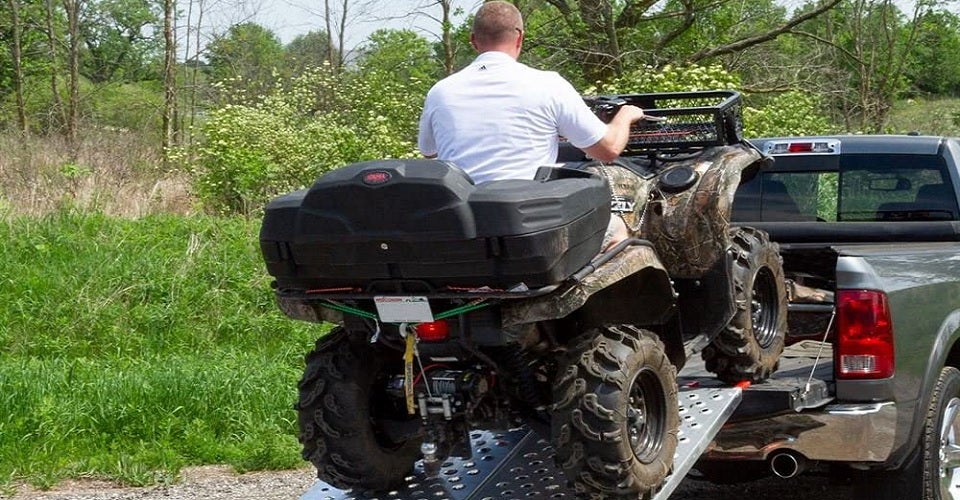
Types of Loading Ramps
Loading ramps range from golf cart ramps to hydraulically operated moving van lifts. For today’s article, we’re talking about smaller loading ramps. We’ll focus on ramps for power equipment, moving dollies, and small wheeled vehicles.
In terms of design considerations, there are basically two approaches. Some ramps use two small wheel ramps to lift and guide the wheels of ATVs, mowers, or golf carts for instance. Alternately, another approach is a one-piece ramp wide enough for walking up, driving power equipment up, or wheeling a moving dolly.
One-piece ramps are generally more useful for a wide variety of loading. Foot traffic, dollies, or wheeled vehicles can all use this type of ramp.
Two-piece ramps, however, are usually exclusively helpful for loading power equipment like ATVs and such.
Of course, while the wide, one-piece ramp is convenient for a wide variety of things it does come with drawbacks. Because of their larger footprint, one-piece ramps are heavier and bulkier than two-piece ramps.
Vehicle Considerations
Let’s face it, the majority of loading ramps are used for some type of vehicle. Loading motorcycles, ATVs, snowmobiles, or sometimes even other trucks or cars.
Before you pull the trigger on purchasing you need to think through what will be loaded with your ramp. This factor is important not just now, but in the future as well. Right now you might just have a golf cart but what are the chances you might have a heavier, larger vehicle a couple of years down the road that you want to load up?
Instead of buying multiple ramps, you might want to go up a notch or two and buy a ramp that can handle what you have and more for future situations whether you’re loading your equipment or that of a friend.
With that said, you also need to think about how your vehicle is designed. Vehicles with small wheels, for instance, need loading ramps with closely spaced (or flat) ramp surfaces. Large wheeled vehicles, on the other hand, can handle ramps with more aggressive or sparsely spaced slats on the loading surface.
For motorcycles, you’ll want a loading ramp with lots of grip and texture. Smooth surfaces are slippery for your feet and for the bike. Of course, the last thing you want is for a silly mistake to cause you to drop your bike off the ramp.
It’s also important that you ensure the wheels of the vehicle you’re loading will fit in the width of the ramp. Give yourself plenty of extra room, as well. If your vehicle tires are 7” wide, don’t go with a 7.5” wide ramp. Leaving extra wiggle room means you’ll have more opportunities to adjust from side to side as you load your vehicle.
Ramp Length
Ramp length is an extremely important factor in choosing a ramp. Longer ramps provide flatter inclines which make loading easier and safer.
Short ramps usually result in steep loading angles. Steep loading angles directly correlate to loading hazards!
Generally, ramps for your average pickup truck range from 7’ long and onward. Since flatter loading angles are always better for ease of loading, going with the longest ramp you can afford, transport, and store is almost certainly a good idea.
It’s important to know the height of your loading surface when choosing a ramp length. Be sure to cross-reference this with the recommended maximum height specified by the ramp manufacturer before using.
Ramp Width
We touched on this briefly in the “Vehicle Considerations” section.
Ramp with for two-piece ramps should be a good margin wider than the tires on the vehicle you’re loading. While most ramps have bumpers on the edge, the last thing you want is to accidentally roll a wheel off the ramp.
For one-piece ramps, width depends on what you’re using it for. Maybe the most common use for one-piece ramps is to load motorcycles.
In the case of motorcycle loading, you want the ramp to be wider than your legs when they’re at rest supporting your bike. You need enough room to spread your feet wide to balance and stabilize the bike without slipping a foot off the edge of the ramp.
Another common use for one-piece ramps is moving and hauling. If you want to walk in and out of the truck bed or van bed a ramp as close to the full width of the vehicle as possible is best. Whether you’re wheeling around a moving dolly or carrying a couch up the ramp, more width is best for general moving and loading.
Weight Capacity
One of the most important objective factors in choosing a loading ramp is weight capacity. Depending on the materials and engineering of each ramp design, the safe working load can vary quite dramatically.
Before committing to a loading ramp be sure to consider the weight of the vehicle or objects being loaded. Don’t forget to factor in the fully-loaded weight of the vehicle, too! Account for the weight of the drive and all addons or accessories on the vehicle.
If you’re loading a 500-pound ATV with a 250-pound rider and 30 pounds of gear you’ll want a ramp well in excess of the combined 780 pounds to have a safe working margin of error.
Remember that in the case of two-piece ramps you’ll want to be sure the weight capacity is clearly stated. One confusing point is that two-piece ramp capacities can be listed per set or per ramp.
For instance, a rating of 1,000 pounds per ramp means that together the two pieces can handle a total of 2,000 pounds. Inversely, a set of ramps rated for a combined 2,500 pounds can hold 1,250 per ramp.
Unless you plan on only using one ramp out of a combined set, the more important number to know is the combined rating which must be safely above the load you plan to subject the ramps to.
Also, remember that weight ratings tend to be static load limits. While an 800-pound ATV sitting still exerts 800 pounds of force on a ramp the same is not true of said ATV when in motion. For instance, if you were to hit the loading ramp with some speed, the dynamic forces at play on the ramp could sharply increase the force exerted on the ramp leading to sometimes exponential load increases.
Always load slowly and steadily.
FAQs About Loading Ramps
Q: How do you secure a ramp to the tailgate?
A: There are countless “fail” videos on the web involving poorly secured ramps and operators loading them. While they may be funny videos, they usually result in physical harm or damage to property. Let’s avoid that!
First, and most importantly, I should say that everyone needs to consult the operator’s manual for their ramp. Every ramp is different so the best way to ensure you’re securing it properly is to use the manual.
That said, most ramps can be secured by using a strap. Ratchet or pull straps will both typically work.
- Set the ramp in position.
- Attach strap to the ramp’s anchor point.
- Attach the other end of the strap to the vehicle’s receiver or bumper.
- Tighten until the ramp cannot kick backwards away from the vehicle.
That’s really all there is to it.
Ramps are made to support and distribute weight across the tailgate or loading area of the trailer or vehicle. Using a strap simply helps to ensure that the ramp can’t move backwards out of position during the loading or unload process.
Q: How do I stop my ATV ramps from sliding?
A: In order to prevent sliding you’ll want to look for a couple key features.
One key feature is a positive grip on the lip of your tailgate or trailer. Some ramps have grippy rubber fingers that interface with your tailgate to help prevent sliding. Of course, this isn’t the only solution.
When you combine a good, positive, grip on the tailgate with safety straps (see above) it will help ensure nothing slides around.
Another good feature to look for is traction on the ramps themselves. To prevent the power equipment from slipping, good positive traction is critical for rubber-ramp interface. If your tires slip the weight could shift or you may accidentally gas the vehicle causing stress on the ramps.
Video: Tips on loading your ATV onto your truck
Q: Are steel or aluminum ramps better?
A: Either material will work fine as long as it’s manufactured to handle what you want to do with it.
Steel is usually cheaper when comparing apples to apples. However, it’s also much heavier. For that reason you may want to consider whether or not it fits your needs. If you have trouble moving or lifting then you may want to save some weight by going to aluminum.
Steel is, unfortunately, prone to rusting over time. It would take a very long time for steel ramps to rust to the point of being dangerous, though.
Aluminum is lighter, rust-proof, and can be made into just as strong of a ramp as steel. However, you’ll probably pay quite a bit more for aluminum ramps. Will this pay off in the long run though? That’s up to you.
Q: How do I care for my loading ramps?
A: Aluminum loading ramps don’t need much upkeep. They can’t rust and are unlikely to be hurt by storing them in just about any place around the house, garage, or yard.
Steel ramps, however, need a bit more care. Try to store them in a dry location out of the elements. Fold them up and install a way to hang them on the wall of the garage or barn.
Over time if your ramps begin to rust you can paint right over them with a liberal application of rust-resistant spray paint.
Do your best to store your ramps where they’re unlikely to rust and, if they do show signs of rust, give them a quick paint job!
Q: What’s the shortest ramp I can safely use?
A: This is a tricky question.
At the end of the day, my biggest recommendation is that you use the longest ramp you can find and transport.
Why? Because the flatter the incline on your loading ramp (longer ramps) the safer and easier it is to load up. Steep ramp angles come with many dangerous hazards.
Never try to push yourself to use a short ramp as physical or property damage can result!
Conclusion
When it’s time to load up the power toys, you’ll need a good set of ramps. Paying for quality ramps and ensuring that you’re using them properly will help extend the healthy life of you, your truck, and your power equipment.
We’ve included ramps on our list to fit a variety of different power equipment and situations. Whether you need to load the truck or the trailer, there’s a ramp on our list that will make you happy!
Before you go out and buy a ramp be sure to reread the “how to choose” section for some purchasing tips.
How We Researched
To come up with the top loading ramps, we researched a variety of sources for reviews such as Camping World, Lazy Days, Real Truck and Walmart along with our own personal experience.
We also consulted online magazines for product research and reviews to get as much unbiased information as we could. To help weed out fake reviews we used Fakespot.com to make sure we only looked at genuine reviews.
With so much quality gear available, we had to narrow it down based on what we felt were the best options for the price. The staff authors have a wide and varied background in RV camping, automotive repairs and backpacking.
The authors have decades of experience and are eager to share their knowledge with readers.
To help narrow down the selection we used personal experiences along with recommendations from mechanics and retailers.
After extensive research, we came up with our list to help you choose the right one for you.
Sources
